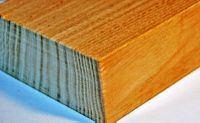Difference between revisions of "Castanea sativa"
From eagle-rock.org
| Line 5: | Line 5: | ||
== Use of wood == | == Use of wood == | ||
| + | [[File:Sweet chestnut wood.JPG|200px|thumb|left|Sweet chestnut wood]] | ||
: This tree responds very well to coppicing <ref>[http://en.wikipedia.org/wiki/Coppicing Coppicing - Wikipedia]</ref>, which is still practised in Britain, and produces a good crop of tannin-rich wood every twelve to thirty years, depending on intended use and local growth rate. The tannin renders the young growing wood durable and resistant to outdoor use, thus suitable for posts, fencing or stakes. The timber of the species is marketed as chestnut. The wood is of light colour, hard and strong. It is also used to make furniture, barrels (sometimes used to age balsamic vinegar), and roof beams notably in southern Europe (for example in houses of the Alpujarra, Spain, in southern France and elsewhere). The timber has a density of 560 kg per cubic meter, and due to its durability in ground contact is often used for external purposes such as fencing. It is also a good fuel, though not favoured for open fires as it tends to spit. <ref>[http://en.wikipedia.org/wiki/Sweet_chestnut Castanea sativa - Wikipedia]</ref> | : This tree responds very well to coppicing <ref>[http://en.wikipedia.org/wiki/Coppicing Coppicing - Wikipedia]</ref>, which is still practised in Britain, and produces a good crop of tannin-rich wood every twelve to thirty years, depending on intended use and local growth rate. The tannin renders the young growing wood durable and resistant to outdoor use, thus suitable for posts, fencing or stakes. The timber of the species is marketed as chestnut. The wood is of light colour, hard and strong. It is also used to make furniture, barrels (sometimes used to age balsamic vinegar), and roof beams notably in southern Europe (for example in houses of the Alpujarra, Spain, in southern France and elsewhere). The timber has a density of 560 kg per cubic meter, and due to its durability in ground contact is often used for external purposes such as fencing. It is also a good fuel, though not favoured for open fires as it tends to spit. <ref>[http://en.wikipedia.org/wiki/Sweet_chestnut Castanea sativa - Wikipedia]</ref> | ||
Revision as of 07:02, 3 February 2012
Chunks of information
Use of wood
- This tree responds very well to coppicing [1], which is still practised in Britain, and produces a good crop of tannin-rich wood every twelve to thirty years, depending on intended use and local growth rate. The tannin renders the young growing wood durable and resistant to outdoor use, thus suitable for posts, fencing or stakes. The timber of the species is marketed as chestnut. The wood is of light colour, hard and strong. It is also used to make furniture, barrels (sometimes used to age balsamic vinegar), and roof beams notably in southern Europe (for example in houses of the Alpujarra, Spain, in southern France and elsewhere). The timber has a density of 560 kg per cubic meter, and due to its durability in ground contact is often used for external purposes such as fencing. It is also a good fuel, though not favoured for open fires as it tends to spit. [2]
Gallery
See also
References
External links
- Castanea sativa Wikipedia



